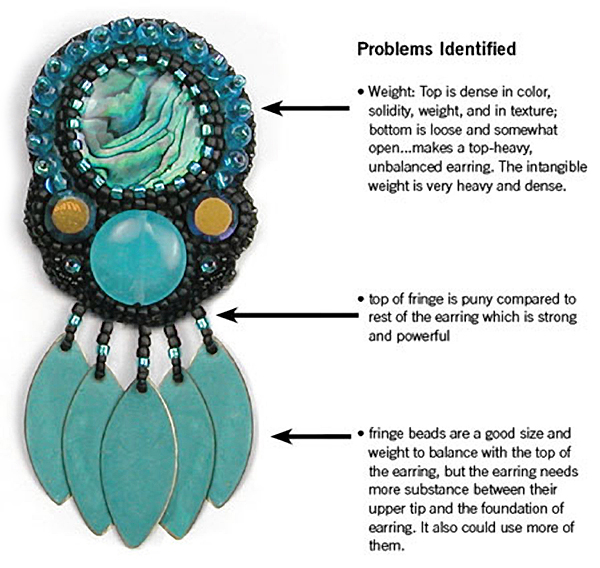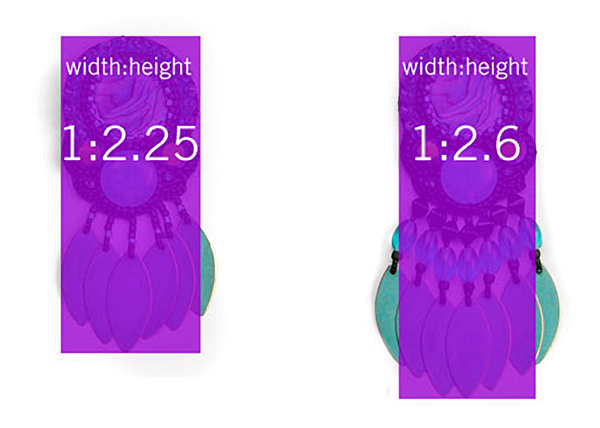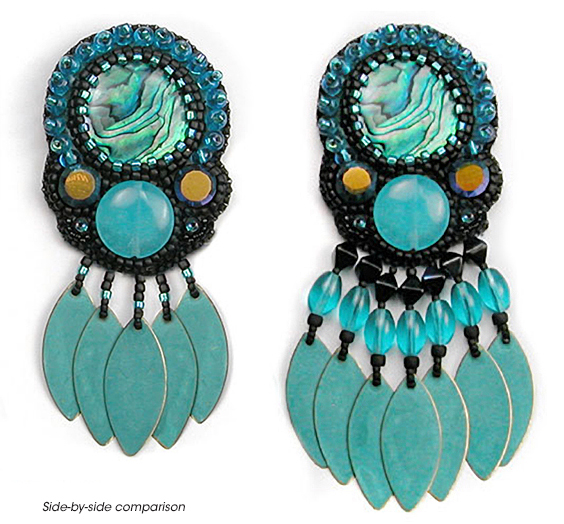Let's learn about balance and proportion. Previously, Margie Deeb has discussed how color is fundamental when designing jewelry. Today we are going to learn about intangible weight. Weight and balance affects how a piece of jewelry will appear and how it will drape or dangle. How does intangible weight affect your jewelry? Read on to find out.
We love Margie Deeb's intimate knowledge of colors and we wanted to re-share some of our archive articles she has written for us. Margie is an incredibly talented artist, designer, and author. Follow along on her color journey. Let's all become students of color!
Below, Margie discusses how using weight adds significance to the visual appearance of an earring. This sense of proportion and balance determines how visually stimulating the jewelry is and how well it dangles off the ear. Be mindful of your shapes and weight and your jewelry will be fabulous.
I'm going to focus on design this month. I want to explore what I call intangible weight, which is so important in jewelry design. This concept plays a critical role in the balance and proportion of your designs. I refer to this weight as "intangible" because you can't measure it. Intangible weight does include what you can measure. And it also includes what you see, feel, and most important, what you sense. Rev up your intuition for this, folks!

I was pleased with the earring above. I liked the width-to-height ratio. The colors were perfect. The pair looked lovely on my work table, so I finished them. When I tried them on, they didn't work. They looked clunky. Since most women don't do "clunky," and I intended to sell these, they needed to be a bit more elegant. "Longer" was the first solution that came to mind. But not just longer...I knew the fringe needed to be both longer and more substantial to balance the bulk of the earring itself. But whoa... these were already large, dramatic statements. Dare I make them longer?

After measuring, comparing proportions, and trying various fringe variations, below is the final pair. They look beautiful hanging from ears. They were purchased before the show began, by a black-haired beauty with dark eyes, whose fashion style flows effortlessly from dramatic to elegant, and always makes a bold statement.

Let's examine the width-to-height ratio to see what we can learn.
Note: In my measurement of total width I've not included the width of the fringe because when the earrings hang, the fringe width will narrow to match the width of the top.

Image on Left: The initial earring width-to-height ratio is 1:2.25
In looking at the purple rectangle, I find that ratio very pleasing and elegant. It's very close to 1:2, which is a standard, commonly agreed upon as harmonious ratio. But given the intangible weight of the top of the earring, which includes the visual density, weight, texture, color, and substance, the earring needs to be somewhat longer to be just right.
Image on Right: The final width-to-height ratio is 1:2.6
In addition to making the fringe longer and wider, I made it more substantial by adding more beads to thicken each strand. If I'd not taken into account the intangible weight and made the earring longer - not more substantial - the outcome would have been unbalanced. The fringe required more substance to balance the intangible weight of the top.

Interestingly, the earring on the left, the one that looked so clunky when worn, does not look as clunky when presented by itself. Even now as I look at it on the page I really like it. But believe me, it looked bad when worn. The imbalance was so much more obvious when in context, i.e.: on a person.
Lessons Learned
Always look at the piece in context before finishing
Take into account the intangible weight: how heavy (or light) you sense the piece (or part of the piece) is. Color accounts for part of this intangible weight. So does texture.
A standard harmonious proportion (like 1:2) is only going to work if the intangible weight is taken into account.
Join our
Facebook group – VIB. Stay in the know. Stay up to date. From our bead shows to our video shows and sales, you can stay in touch with us. The community is full of artistic and helpful beaders and crafty people. Inspire and be inspired. Share your pictures and get the beading bug from others!
Visit the
Soft Flex Company YouTube Channel!

Artist and color expert Margie Deeb is the author of The Beader's Color Palette, The Beader's Guide to Color, The Beader's Guide to Jewelry Design and numerous beading and color publications. She teaches color and beading across the country and her free monthly color column, Margie's Muse, is available on her website. She writes regularly for Beadwork, Bead & Button, and Step-by-Step Beads magazines.
Visit Margie's website for her books, kits, patterns, jewelry, inspiration, and more: www.MargieDeeb.com



